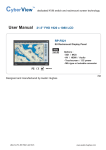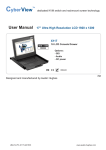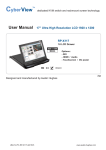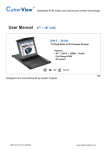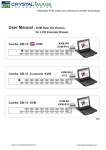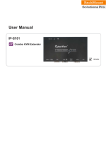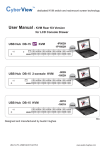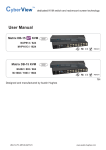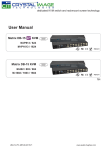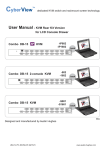Download User Manual - Austin Hughes
Transcript
dedicated KVM switch and rackmount screen technology User Manual IP-S101 Combo KVM Extender 751 Designed and manufactured by Austin Hughes UM-CV-751-IP-S101-Q315V3 www.austin-hughes.com Legal Information First English printing, October 2002 Information in this document has been carefully checked for accuracy; however, no guarantee is given to the correctness of the contents. The information in this document is subject to change without notice. We are not liable for any injury or loss that results from the use of this equipment. Safety Instructions Please read all of these instructions carefully before you use the device. Save this manual for future reference. ■ ■ ■ ■ ■ ■ ■ ■ ■ ■ ■ Unplug equipment before cleaning. Don’t use liquid or spray detergent; use a moist cloth. Keep equipment away from excessive humidity and heat. Preferably, keep it in an air-conditioned environment with temperatures not exceeding 40º Celsius (104º Fahrenheit). When installing, place the equipment on a sturdy, level surface to prevent it from accidentally falling and causing damage to other equipment or injury to persons nearby. When the equipment is in an open position, do not cover, block or in any way obstruct the gap between it and the power supply. Proper air convection is necessary to keep it from overheating. Arrange the equipment’s power cord in such a way that others won’t trip or fall over it. If you are using a power cord that didn’t ship with the equipment, ensure that it is rated for the voltage and current labeled on the equipment’s electrical ratings label. The voltage rating on the cord should be higher than the one listed on the equipment’s ratings label. Observe all precautions and warnings attached to the equipment. If you don’t intend on using the equipment for a long time, disconnect it from the power outlet to prevent being damaged by transient over-voltage. Keep all liquids away from the equipment to minimize the risk of accidental spillage. Liquid spilled on to the power supply or on other hardware may cause damage, fire or electrical shock. Only qualified service personnel should open the chassis. Opening it yourself could damage the equipment and invalidate its warranty. If any part of the equipment becomes damaged or stops functioning, have it checked by qualified service personnel. What the warranty does not cover ■ ■ ■ Any product, on which the serial number has been defaced, modified or removed. Damage, deterioration or malfunction resulting from: Accident, misuse, neglect, fire, water, lightning, or other acts of nature, unauthorized product modification, or failure to follow instructions supplied with the product. Repair or attempted repair by anyone not authorized by us. Any damage of the product due to shipment. Removal or installation of the product. Causes external to the product, such as electric power fluctuation or failure. Use of supplies or parts not meeting our specifications. Normal wear and tear. Any other causes which does not relate to a product defect. Removal, installation, and set-up service charges. □ □ □ □ □ □ □ □ Regulatory Notices Federal Communications Commission (FCC) This equipment has been tested and found to comply with the limits for a Class B digital device, pursuant to Part 15 of the FCC rules. These limits are designed to provide reasonable protection against harmful interference in a residential installation. Any changes or modifications made to this equipment may void the user’s authority to operate this equipment. This equipment generates, uses, and can radiate radio frequency energy and, if not installed and used in accordance with the instructions, may cause harmful interference to radio communications. However, there is no guarantee that interference will not occur in a particular installation. If this equipment does cause harmful interference to radio or television reception, which can be determined by turning the equipment off and on, the user is encouraged to try to correct the interference by one or more of the following measures: ■ Re-position or relocate the receiving antenna. ■ Increase the separation between the equipment and receiver. ■ Connect the equipment into an outlet on a circuit different from that to which the receiver is connected. UM-CV-751-IP-S101-Q315V3 www.austin-hughes.com Contents < Part. 1 > IP-S101 1.1 1.2 Package Contents Specification P.1 P.2 < Part. 2 > Application 2.1 2.2 Connection to KVM console port over IP Connection to computer over IP P.3 P.4 P.5 - 7 < Part. 3 > IP Initial Setup Before Installation ■ It is very important to mount the equipment in a suitable cabinet or on a stable surface. ■ Make sure the place has a good ventilation, is out of direct sunlight, away from sources of excessive dust, dirt, heat, water, moisture and vibration. Unpacking The equipment comes with the standard parts shown in package content. Check and make sure they are included and in good condition. If anything is missing, or damaged, contact the supplier immediately. < Part 1 > IP-S101 < 1.1 > Package Contents IP-S101 unit X 1 - CE-6 6ft Combo KVM cable X 1 - Power adapter w/ power cord ( for receiver ) X 1 UM-CV-751-IP-S101-Q315V3 P.1 www.austin-hughes.com < 1.2 > Specification IP-S101 USB Mouse KB VGA Virtual KVM / PC Media Serial LAN Front Power PS/2 Mouse KB Rear IP-S101 Specification IP Connection 1 x RJ-45 Ethernet 10/100 Console connection 1 XDB-15 VGA, up to 1600 x 1200 2 x USB type connector for keyboard & mouse 2 x PS/2 mini Din 6-pin for keyboard & mouse PC connection 1 x DB-15 combo KVM port Virtual Media USB type B receptacle Serial 1 x DB9 male Power 12V power adapter Operation Temperature 0 ~ 55 °C Storage Temperature -5 ~ 60 °C Humidity 0~80%, Non-Condensing Dimension 203.5W x 113.3D x 27.3H mm Weight 1.7 kg / 3.74 lb Environmental RoHS2 & REACH compliant UM-CV-751-IP-S101-Q315V3 P.2 www.austin-hughes.com IP-S101 < Part 2 > Application < 2.1 > Connection to KVM console port over IP USB Console KVM switch 32 31 30 29 28 27 26 25 16 15 14 13 12 11 10 9 24 23 22 21 20 19 18 17 8 7 6 5 4 3 2 1 CE-6 combo KVM cable Rear Front Monitor CAT 5 / 6 cable max. 100m Network device hub or router Inter net UM-CV-751-IP-S101-Q315V3 P.3 www.austin-hughes.com IP-S101 < 2.2 > Connection to computer over IP Computer CE-6 combo KVM cable Rear Front Monitor CAT 5 / 6 cable max. 100m Network device hub or router Inter net UM-CV-751-IP-S101-Q315V3 P.4 www.austin-hughes.com IP-S101 < Part 3 > IP Initial setup After the cable connection, please take the following steps to configure the IP KVM Extender : 1. Download IPKVMsetup.exe from the link: www.austin-hughes.com/support/utilities/cyberview/IPKVMsetup.exe 2. Double click IPKVMsetup.exe to configure the IP KVM Extender by device setup as below. 3. 4. 5. 6. 7. 8. 9. Click Refresh Device to search the connected IP KVM Extender Select the M.A.C. address, which you want to setup, then click Query Device Enter Super user login. The default is super Enter Super user password. The default is pass Enter the new super user password Re-enter the new password Change the desired IP address / Subnet mask / Gateway, then click Setup Device to confirm the setting to IP KVM Extender 10. The default address is http://192.168.1.22 11. Open Internet Explorer ( I.E. ), version 6.0 or above 12. Enter the IP KVM Extender address into the address bar - For Single IP - http://192.168.1.22 13. Enter username ( default is super ) Password ( default is pass ) 14. After successful login to IP KVM Extender, the user will enter the main page of IP KVM Extender The setting is enough for intranet. If the users access KVM GUI via internet, please ask MIS for assistance and download IP KVM user manual from the link : www.austin-hughes.com/support/usermanual/cyberview/UM-CV-IP.pdf UM-CV-751-IP-S101-Q315V3 P.5 www.austin-hughes.com IP-S101 Important Preconfiguration for IP console You must complete the following tasks after the IP console setting is performed. ( 1 ) TARGET SERVER SETUP **Servers connected to KVM Resolution The IP KVM remote console recognizes several varieties of video display formats with resolutions up to 1600 x 1200 @60Hz. (Refer to the User Manual for a list of supported video formats). Minimize bandwidth by setting the target server’s video resolution to the minimum setting required for your remote monitoring application. The following video modes are recommended: (i) 800 x 600 @ 60Hz (ii) 1024 x 768 @ 60Hz (iii) 1280 x 1024 @ 60Hz On a Windows target server system, select Control Panel > Display > Settings. Modify the screen resolution value as necessary. Mouse Use generic mouse drivers for optimum mouse control during remote sessions. Set the mouse pointer speed to a middle setting with no acceleration or snap-to effects. On a Windows target server system, select Control Panel > Mouse > Pointer Options Set the pointer speed to medium and disable Enhanced pointer precision For Linux GUIs, set the mouse acceleration to exactly 1 and the threshold to exactly 1. If your keyboard keeps repeating keys when it is plugged into the KVM. Please follow either one below : ( a. ) Enable key release timeout if you experience duplicated keystrokes during poor network performance. - login to IP KVM remote console - go to Interfaces KVM settings > Keyboard / Mouse - click the Key Release Timeout - adjust Timeout after if necessary ( b. ) Reduce video bandwidth usage if you experience duplicated keystrokes during poor network - login to IP KVM remote console - go to Interfaces KVM Settings > User Console > Transmission Encoding, - select Manually - adjust Compression to [ 0-none ] and Color depth to [ 8-bit – 256 col ] UM-CV-751-IP-S101-Q315V3 P.6 www.austin-hughes.com IP-S101 Important Preconfiguration for IP console ( 2 ) REMOTE CLIENT COMPUTER SETUP The remote client computer must have a web browser ( such as Microsoft Internet Explorer, Mozilla Firefox, and Netscape Navigator ) and a Java Virtual Machine ( version 1.4 or higher ) installed. Enable Java on the web browser. JAVA Security Issue Due to the changes from Java security, customer may facing the "JAVA Block" message while accessing the remote console over IP. If it said so, here is the workaround solution : Customer can use the "Exception Site list" feature to run the applications blocked by security setting. Adding the URL of the blocked application to the Exception Site list allows it to run with some warnings. Steps to Add URLs to the Exception Site list : ■ Go to the Java Control Panel ( On Windows Click Start and then Configure Java ) ■ Click on the Security tab ■ Click on the Edit Site List button ■ Click Add in the Exception Site List window ■ Click in the empty field under the Location field to enter the URL ( URL should begin with http:// or https:// ) UM-CV-751-IP-S101-Q315V3 P.7 www.austin-hughes.com The company reserves the right to modify product specifications without prior notice and assumes no responsibility for any error which may appear in this publication. All brand names, logo and registered trademarks are properties of their respective owners. Copyright 2015 Austin Hughes Electronics Ltd. All rights reserved. UM-CV-751-IP-S101-Q315V3 www.austin-hughes.com












